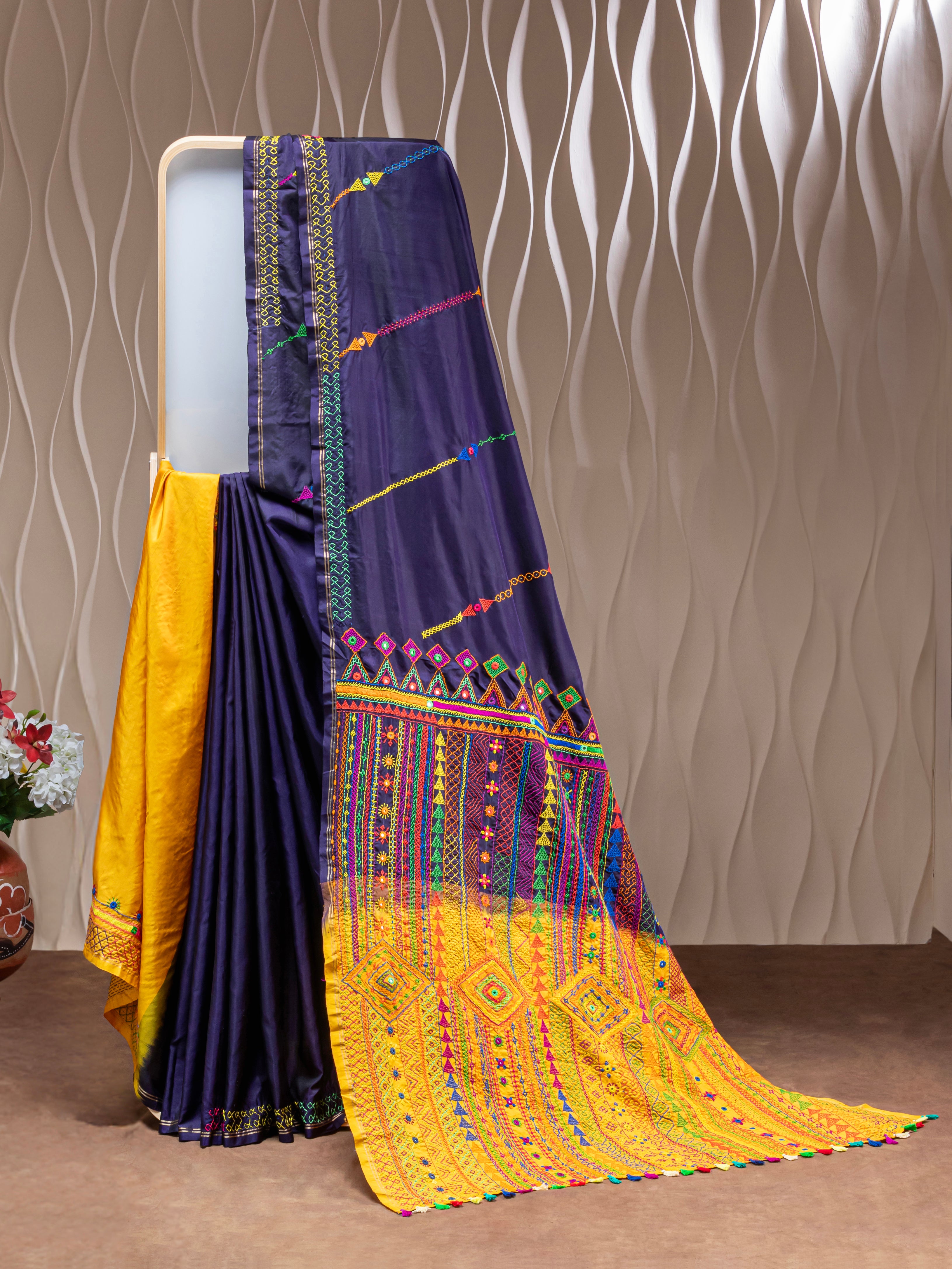⸻ Title: A Thread Through India: Exploring the Diverse Embroidery Styles of India
India is a land of colors, stories, and stitches — quite literally! With its vast cultural landscape, India is home to over 30 types of unique embroidery styles, each telling a tale of tradition, heritage, and regional pride. Every state, community, and even tribe has nurtured its own signature embroidery technique, shaped by local history, environment, and aesthetics.
In this blog, we take you on a colorful journey across Indian states, discovering the rich embroidery heritage of the country.
North India – Threads of Elegance
Punjab – Phulkari
‘Phulkari’ literally means “flower work.” It is an age-old tradition where vibrant silk threads bloom into floral motifs on shawls and dupattas. Symbolizing joy and celebration, this art is passed from mothers to daughters.
Jammu & Kashmir – Kashida and Aari
Kashida embroidery reflects the beauty of nature — birds, leaves, and flowers embroidered in a single stitch style on warm wool fabrics. Aari work, on the other hand, uses hooked needles to create fine chain-stitch designs, commonly seen on Kashmiri shawls and carpets.
Uttar Pradesh – Chikankari
From the royal courts of Lucknow, Chikankari is delicate, intricate, and graceful. White thread is used on light fabrics like muslin or cotton, creating patterns that look almost like lace — timeless and elegant.
Himachal Pradesh – Chamba Rumal
This double-sided embroidery is often used to narrate mythological tales. It’s done with silk threads on hand-spun cloth, often gifted during weddings and ceremonies.
West India – Mirrors, Metals, and Motifs
Rajasthan – Gota Patti, Zardozi & Mukaish
Rajasthan dazzles with its embroidery! Gota Patti uses applique and ribbon work in gold and silver, often on festive attire. Zardozi embroidery uses metallic threads for royal grandeur, while Mukaish adds tiny silver dots to fabric, making it shimmer.
Gujarat – Kutch, Rabari, and Suf Embroidery
Gujarat is a treasure trove of embroidery styles.
• Kutch embroidery is famous for its mirrors and bold geometric patterns.
• Rabari embroidery, practiced by the Rabari tribe, uses storytelling through threads.
• Suf embroidery is a counted thread style — subtle, symmetrical, and detailed.
Maharashtra – Kasuti (shared with Karnataka)
Though primarily found in Karnataka, this embroidery is also part of Maharashtrian textile heritage. It involves intricate, symmetrical patterns often inspired by temple architecture.
Central India – Tribal Vibrance
Madhya Pradesh – Zardozi & Banjara Embroidery
The Zardozi work here continues the Mughal legacy with metallic thread embroidery. The Banjara community contributes with their vibrant tribal embroidery — full of mirrors, beads, and bold stitches.
East India – Simplicity Meets Storytelling
West Bengal – Kantha
One of India’s most popular embroidery forms, Kantha started as a way to reuse old saris and cloth. Women stitched layers of fabric together using running stitches to create beautiful motifs — birds, flowers, and folk tales.
Bihar – Sujani Embroidery
Another narrative form, Sujani uses running stitches and outlines to create scenes from village life, often with messages around social issues or mythology.
Odisha – Pipli Appliqué Work
This colorful appliqué art involves stitching shaped fabric pieces onto a base cloth. You’ll find elephants, birds, flowers, and sun motifs — often used in temple decorations and processions.
South India – Precision and Passion
Karnataka – Kasuti & Lambani Embroidery
• Kasuti is a geometric, counted thread style that requires mathematical precision. Often used in Ilkal sarees, it features chariots, lamps, and temple towers.
• Lambani embroidery, practiced by the Lambani tribal women, is rich with mirrors, shells, beads, and vibrant colors — a symbol of nomadic joy and resilience.
Andhra Pradesh / Telangana – Banjara Work
Here too, Banjara communities create dazzling pieces with mirror work, shells, and bold threads stitched in geometric patterns.
Tamil Nadu – Pachai Kuthuvam
Less known but equally beautiful, this style takes inspiration from temples and nature, stitched in bold colors on earthy fabrics.
Kerala – Kasavu-Inspired Embellishment
While not known for embroidery in the traditional sense, Kerala’s minimalist Kasavu sarees are sometimes enhanced with simple, gold-threaded temple motifs and Kathakali designs.
North-East India – Tribal Identities in Threads
The North-Eastern states like Nagaland, Manipur, and Mizoram have their own tribal embroidery traditions — deeply woven into their identity. Each tribe has distinct patterns, colors, and styles — most often integrated into their woven garments and accessories.
A Tapestry of Traditions
From the elegant whites of Lucknow’s Chikankari to the vibrant mirrors of Gujarat’s Kutch, Indian embroidery is as diverse as its people. These art forms are more than just stitches — they are stories, rituals, and legacies passed down through generations.
At Sooji Daara, we celebrate and support traditional crafts like Lambani embroidery — keeping the culture alive through design, dignity, and employment. Every stitch carries the voice of a woman, the spirit of a community, and the soul of India.

